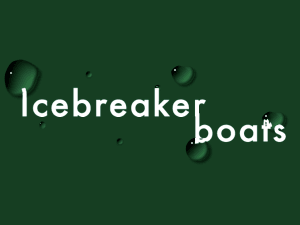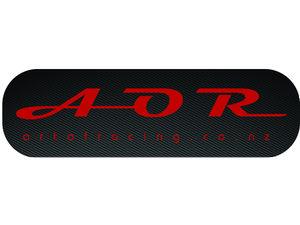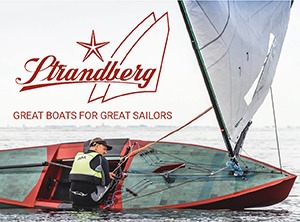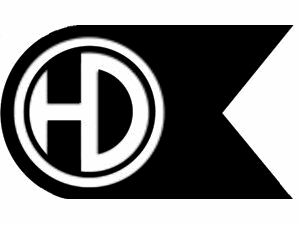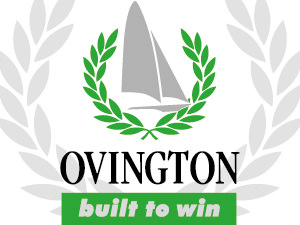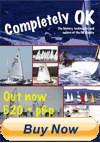You are here: okdia.org > press > 10 world champ chat
Press Release
Back to press release list
Downlaod this article as PDF, with additional photos (ZIP, 344 KB)
OK Dinghy World Champions Chat - 18. January 2010
With the 2010 OK Dinghy World Championship being held next month in 'windy' Wellington, New Zealand, the past three world champions – Nick Craig (2005, 2006, 2007), Karl Purdie (2008) and Thomas Hansson-Mild (2009) – talk about the class, the racing and their thoughts on last year's and this year's championship.
For current world champion Thomas Hansson-Mild (SWE) victory last year in Kalmar, Sweden, was a dream come true. With 20 years experience under his belt and a host of top ten places, many thought Thomas had missed his chance. However, he kept plugging away and was finally back at the front in 2008 where he finished fifth overall.
Explaining his return to form he said, “Sailing is a sport of details, and when it comes down to it everything has to work smoothly. Family support and friends are also vital parts to get the puzzle done. Someone once said that there is need for about 10,000 training hours to become really good in a sport. OK Dinghy sailing is no exception. I began to sail very early and it's no myth that what pushed me towards my dinghy sailing was a rather troublesome pollen allergy. I did not have the allergy on the water and the bay at home became my playground in the summer.”
“In 2007 I saw how quickly Karl Purdie (NZL), sailed, and what equipment he had. He did not win the worlds that year, but he showed a momentum I had never seen before. I realised then that we were stuck in old thinking and had to reconsider. I bought a new mast and switched sail makers to Quantum. Before the 2008 World Championships, I had been training well and finished fifth with a taste for more. I won the last race and ended up just five points from the bronze medal. I went home with the feeling that now I could compete with the finest elite and this spurred me to take another step forward.”
“In the Spring of 2009, I ordered a new mast from C-Tech, New Zealand, which is at the forefront in the development of carbon fibre masts. Unfortunately, the delivery of new mast was delayed due to the pirates around Africa, so I did not have enough time to test what I wanted. But at a training camp in Kalmar, and at the world qualifiers my results confirmed that I was on the right track. It meant that I could skip Kiel Week and Warnemünde and, instead, invest in training. Mentally, it was good to skip the big regattas; I did not have any doubts about myself and the gear, but I thought it would be good not to get last minute uncertainty.”
“During the worlds I knew I had the opportunity to win if I just stayed focused. I also managed to recover and come back again. I just had to have this gold, and I felt that it was within reach, even if Karl did have a grip on it for most of the week. It may sound strange that I say so, especially since it was not until the finish of the last race when it became clear I would win, but I had felt all week long that this would just happen - no matter what.”
“In the end it felt good, really good actually. I felt a deep joy and relief when I think back on it, but I also remember having a certain emptiness after exhausting all my strength. But I think that feeling was more due to fatigue after the effort, than anything else. But now, some time afterwards, I begin to look ahead again. It´s been a fantastic feeling of course, being world champion, but as a true Scandinavian it doesn't last too long.”
For 2008 World Champion Karl Purdie (NZL), the 2009 Championship produced mixed feelings.
“Generally I was happy with my performance last year but truthfully, it was gutting to lose by a single point. I'd also lost the Interdominion championships earlier in the year by the same margin and the worlds loss added salt to that wound. There are always could have/would have/should have beens when you look back and think where the two places necessary for the victory may have been gained in races over the ten race series. But then again Thomas could also look back and say if he'd done this or that differently he could have won by more. At the end of the day you just have to learn and move on from your defeats. With the resources I had at the time there wasn't a lot I could have done differently. The gear I was using was certainly good enough to win with. Thomas, at the end of the day, had one less brain explosion than me over that regatta.”
At the 2010 Worlds, Purdie will be competing in his home town, but is in two minds about the pressures this will serve up. “I do feel a little more pressure to perform with the event being hosted in my home town. Every local sailor I'm sure feels the same. Usually though I perform best when I put myself under a little pressure. The great thing about the worlds being held here is that I'm familiar with the local infrastructure and get to sleep at my own house each night.”
The 2008 champion is arguably one of the most prepared sailors in the fleet, leaving nothing to chance and hunting down every bit of speed he can find.
“Over the past year I have been trying a new mast/sail combination which is quite different to what anyone else (except for a few of my club mates) is currently using. As my 2008 worlds winning rig was sent to Sweden for the last worlds and wasn't returning until January 2010, I had to have a second rig here to train with. It was a bit of a no-brainer to try out a few ideas as the previous rig is extremely reliable and a very capable fall back. I think it has a lot of potential and will certainly be one of the rigs I measure in for the worlds. My new rig has been designed to remedy my light airs performance and to have a large crossover range with my existing set up so there should not be any significant decrease in performance if, say over the course of the day, the wind increases from 5 to 20 knots. Of course if the wind get above 20 knots I'm still thinking my older rig may be the way to go.”
And gear, “At this stage I'll be using an Icebreaker hull (the one I won the worlds with in 2008), Ron Bull foils, a Needlespar boom, C-Tech masts and Quantum sails.”
One of the shock results at the 2009 Worlds was the relative poor performance of triple world champion Nick Craig (GBR). His sixth place overall was his worst performance since 2002, but he reveals he had a few issues with boatspeed.
“I was slow upwind in a force 4 and a chop, which was frustrating as they are usually my best conditions in a one-design. I think it was an issue with my rig – either that or I've got old. I've only been able to sail the OK twice since Kalmar so I've tried to resolve the issue with my cheque book. I've bought two new masts as well as doing some sail development. I've also thought about it a lot, but I'm realistic about my goals in Wellington; I'll be lucky if I get a new rig right the first time. My overall plan is to sail the OK a lot in 2011 in preparation for the next year's worlds in Largs, Scotland.”
“This year I am using a Scoles Icebreaker hull, a C-Tech or Ceilidh mast and a Purple sail. The technical side of things is not my strong point as I'm not in the marine industry but I get as involved as much as I can and listen to and learn from experts such as Jim Hunt (the 2004 OK Dinghy World Champion). I'll be playing around with mast and sail combinations at the New Zealand Nationals just before the worlds, before hopefully settling down for the Worlds itself.”
Craig has built a reputation for sailing, and winning, in a wide range of different classes, but always keeps coming back to the OK Dinghy. He said, “It's some of the best international amateur racing there is, with a friendly fleet that knows how to organise a great worlds.”
The last time the OK Dinghy World Championship was in New Zealand, in 2002, the Kiwis took five of the top seven places, with Craig the first European in a lowly eighth overall. This year the Kiwis seem determined to better this performance, but does Craig feel threatened by this?
“I don't find it an issue as they don't try to sail as a team. Once we're racing, it doesn't matter what letters are on each sail. They have a strength in depth, and I just enjoy the challenge of racing against them. I guess they should have sussed some local knowledge, but the bigger advantage they have is that the event is at the end of the Kiwi summer so they will be racing sharp and not have lost their boats in the containers for a few months.”
Over the years many very good sailors have tried and failed to win the OK Dinghy world title – so what does it take to win? “To win any regatta you need good speed, starts and boat handling. To win a worlds over 10 races you need a composed series and a good head for it.”
In Wellington, during the first week of February, we will see who has the best head.
Robert Deaves, 2010
Event website: www.okworlds2010.com

